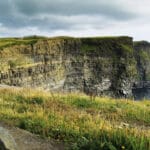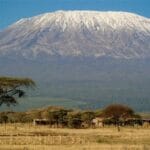Mount Waiʻaleʻale, the second highest peak on Kauai, is renowned as one of the wettest places on Earth, shrouded in mist and nurturing a unique ecosystem. Its Hawaiian name, meaning “rippling” or “overflowing water,” speaks to the near-constant rainfall that shapes this dramatic landscape. Come explore this incredible peak with us, a place often called the wettest spot on the planet. We’ll uncover the secrets of this constantly drenched wonder, from its dramatic, waterfall-streaked cliffs to the amazing plants and animals of the [Alakaʻi Wilderness Preserve](https://www.lolaapp.com/alakai-wilderness-preserve) it calls home. If you’re intrigued by the mysteries of a perpetually rainy realm, prepare for a virtual journey into a world of clouds, waterfalls, and captivating beauty.
The Heart of Kauai’s Rainfall
Mount Waiʻaleʻale, residing at the heart of Kauai, isn’t just a mountain; it’s a realm of perpetual mist, a place where rain isn’t just weather, it’s a defining characteristic. Averaging over 373 inches (9,500 mm) of rain annually, Mount Waiʻaleʻale’s persistent rainfall shapes its dramatic landscape, carves deep canyons, and feeds cascading waterfalls. Imagine a place where, on average, over 31 feet of rain falls every year! This relentless deluge has carved a landscape of dramatic beauty, unlike anywhere else on Earth.
Shaped by Fire and Water: A Geological Story
Rising to 5,148 feet, this shield volcano dominates the heart of Kauai, often veiled in a shroud of mist. Born from volcanic fire millions of years ago, Mount Waiʻaleʻale’s form has been further sculpted over eons by the tireless forces of erosion. The constant rainfall has carved deep canyons and dramatic cliffs, creating a landscape that continues to evolve.
Measuring the Deluge: Gauging the Rain
Accurately measuring rainfall in a place as consistently soaked as Mount Waiʻaleʻale presents unique challenges. Historical records and organizations, including the Guinness Book of World Records and the National Climatic Data Center, offer varying figures, some as high as a staggering 460 inches annually. This discrepancy likely stems from the difficulties in obtaining precise measurements in such extreme conditions. The true average probably lies somewhere in between, shrouded in the very mist that makes measurement so difficult. Some estimates suggest rainfall occurs on 335 to 360 days each year. However, these figures vary over time, due to changes in weather patterns and data collection methods. The number of rain days per year is likely influenced by longer-term climate trends, such as El Niño and La Niña cycles.
So, what makes Mount Waiʻaleʻale such a rain magnet? Its location in the northern Pacific exposes it to moisture-laden weather systems. The trade wind inversion layer, acting like an atmospheric lid, traps clouds below 6,000 feet. The steep slopes of the mountain force this moist air upwards, causing it to cool, condense, and release its moisture as rain. This combination of factors creates a near-constant downpour. Ongoing research continues to examine the interplay of these meteorological factors and how they contribute to Waiʻaleʻale’s extreme rainfall.
Life on a Watery World: The Alakaʻi Wilderness Preserve
The “rippling water” of Waiʻaleʻale sustains the Alakaʻi Wilderness Preserve, a biodiverse bog teeming with rare plant life and shrouded in an ethereal mist. This preserve is a unique ecosystem nestled high on the mountain, a vast, saturated landscape teeming with life specially adapted to thrive in extreme wet conditions. Home to a remarkable array of rare and endemic plant species found nowhere else on Earth, the Alakaʻi Wilderness Preserve represents a delicate balance shaped by the constant rainfall. These hardy species have developed fascinating strategies to survive in this waterlogged world. Some plants, for instance, have evolved specialized leaves to channel water away from their stems, preventing rot and ensuring survival in this perpetually damp environment. Researchers continue to study the unique adaptations of the flora and fauna within the preserve, seeking to understand how this ecosystem thrives under such extreme conditions.
Reaching the Summit: A Hiker’s Journey
Reaching Waiʻaleʻale’s summit is a challenging but rewarding experience, offering breathtaking views and a glimpse into the heart of Kauai’s natural wonders. Conquering Mount Waiʻaleʻale is no easy feat. It’s a challenging trek through thick mud, along slippery trails, and under the constant drumming of rain. While trails like the Blue Hole Hike offer a glimpse into this incredible environment, they are not for the unprepared. Sturdy hiking boots, waterproof clothing and gear, and a healthy dose of determination are essential. Before embarking on this adventure, consult reputable hiking resources and local guides for up-to-date information and safety advice. Trails may be temporarily closed due to weather conditions or other safety concerns. Safety should always be your top priority. The payoff for those who brave the elements? Unforgettable views and the unique experience of standing atop one of the wettest places on our planet. For a different perspective, consider a helicopter tour, which may offer glimpses of the summit and surrounding area, depending on weather conditions.
Whispers of the Past: Cultural Significance
Mount Waiʻaleʻale holds cultural significance for native Hawaiians, its misty peaks woven into local legends and traditions. While specific stories remain elusive, the mountain’s presence undoubtedly played a role in the lives of early inhabitants. Ongoing research and collaborations with cultural practitioners may shed more light on the mountain’s cultural importance. Further investigation into the cultural heritage of Waiʻaleʻale offers an opportunity to understand the deeper connection between the natural world and the human spirit.
More Than Just Rain: Waiʻaleʻale’s Impact
Mount Waiʻaleʻale is more than just a rainy mountain. It’s a dynamic, living laboratory where geology, climate, and biology intertwine. The heavy rainfall carves deep canyons, feeds cascading waterfalls, and shapes the unique flora and fauna. This delicate balance, this world sculpted by rain, is utterly fascinating. Ongoing research continues to explore the complexities of Waiʻaleʻale’s rainfall patterns and their impact on the delicate balance of this precious ecosystem. If you’re planning a trip to Kauai, exploring the wonders surrounding this watery peak should be on your list. Just remember to pack a good raincoat – you’ll probably need it! Embark on a thrilling virtual journey to the majestic Nanga Parbat mountain Pakistan, a breathtaking peak in the Himalayas, or explore the serene beauty of Niassa Lake, a hidden gem teeming with diverse wildlife.
- Discover Words That Start With Co: 15,000+ Found in This Deep Dive - April 4, 2025
- Ultimate Guide to Words Starting With GO: Comprehensive List - April 4, 2025
- Master words that start with o to describe someone: A complete guide - April 4, 2025















